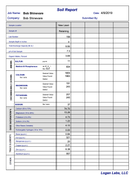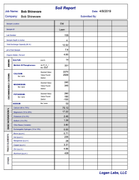Learn how improving your soil can lead to a better looking lawn
-
bob0755
- Posts: 32
- Joined: April 5th, 2018, 4:51 pm
- Location: West Michigan
- Grass Type: Kentucky Bluegrass
- Lawn Size: 5000-10000
- Level: Experienced
Post
by bob0755 » April 3rd, 2020, 4:24 pm
Here are my results for this year (as well as 2019). I am a bit discouraged that despite the monthly SOP applications for the past two years, the PH is going in the wrong direction. My only explanation is that perhaps I mistakenly submitted samples from the top 4 inches in past years, as opposed to the section between 3" and 4" depth??
Is there any harm in increasing either the amount or frequency of SOP applications?
Thanks!



-
andy10917
- Posts: 29744
- Joined: February 23rd, 2009, 10:48 pm
- Location: NY (Lower Hudson Valley)
- Grass Type: Emblem KBG (Front); Blueberry KBG Monostand (Back)
- Lawn Size: 1 acre-2 acre
- Level: Advanced
Post
by andy10917 » April 3rd, 2020, 5:50 pm
Remember to place a LInk in the Soil Test Interpretation Queue, pointing at this thread
-
andy10917
- Posts: 29744
- Joined: February 23rd, 2009, 10:48 pm
- Location: NY (Lower Hudson Valley)
- Grass Type: Emblem KBG (Front); Blueberry KBG Monostand (Back)
- Lawn Size: 1 acre-2 acre
- Level: Advanced
Post
by andy10917 » April 4th, 2020, 1:01 pm
I am a bit discouraged that despite the monthly SOP applications for the past two years, the PH is going in the wrong direction.
I'm confused - you seem to be implying an expected drop in pH from SOP applications. There is no such effect from the use of SOP, and I re-read all of your postings and I don't see anything that could be interpreted that way. Am I misunderstanding the above question?
-
bob0755
- Posts: 32
- Joined: April 5th, 2018, 4:51 pm
- Location: West Michigan
- Grass Type: Kentucky Bluegrass
- Lawn Size: 5000-10000
- Level: Experienced
Post
by bob0755 » April 4th, 2020, 4:18 pm
Wow—I clearly misunderstood your comments...
I also went back and re-read. You referred to the high levels of Calcium and Magnesium, followed by the recommendation to supplement the Potassium. I took that to mean that when the percentages of all three were in balance, the PH would start to come down...
-
andy10917
- Posts: 29744
- Joined: February 23rd, 2009, 10:48 pm
- Location: NY (Lower Hudson Valley)
- Grass Type: Emblem KBG (Front); Blueberry KBG Monostand (Back)
- Lawn Size: 1 acre-2 acre
- Level: Advanced
Post
by andy10917 » April 4th, 2020, 6:22 pm
Nope. The only cation that can be somewhat easily displaced is Magnesium, but that is by using Gypsum (Calcium Sulfate). Magnesium is 1.7X stronger at affecting pH, so displacing it **can** cause a small pH drop. You can't displace too much though as Magnesium is to plants as Iron is to human blood - it's required. Potassium is the weakling for cation effects on pH, at around half that of Calcium.
More on this later when I do the interpretation...
PS: any chance that non-native soil was added at some time in the past?
-
bob0755
- Posts: 32
- Joined: April 5th, 2018, 4:51 pm
- Location: West Michigan
- Grass Type: Kentucky Bluegrass
- Lawn Size: 5000-10000
- Level: Experienced
Post
by bob0755 » April 4th, 2020, 8:01 pm
The “new lawn” is entirely non-native soil, as it was used to fill in a retaining wall. It is just a small area, but I wanted to have it tested out of curiosity, since I paid extra for premium composted topsoil.
When the house was built, the primary lawn area needed a lot of soil to bring it up to grade, but it was from a pile of native soil that was excavated when the road was put in for the new development.
-
bob0755
- Posts: 32
- Joined: April 5th, 2018, 4:51 pm
- Location: West Michigan
- Grass Type: Kentucky Bluegrass
- Lawn Size: 5000-10000
- Level: Experienced
Post
by bob0755 » April 5th, 2020, 10:14 pm
Additional information from last year...
I applied:
Top dressed with peat moss in early Spring
SOP @2lbs/1000 from April through Sep
Milorganite—2 bags per application May through August, mixing in Borax twice
Fall Nitrogen Regime using Ammonium Sulfate
-
andy10917
- Posts: 29744
- Joined: February 23rd, 2009, 10:48 pm
- Location: NY (Lower Hudson Valley)
- Grass Type: Emblem KBG (Front); Blueberry KBG Monostand (Back)
- Lawn Size: 1 acre-2 acre
- Level: Advanced
Post
by andy10917 » April 8th, 2020, 8:47 am
OK - I think the big pH change may be happening due to the fact that the non-native soil and the native soil are mixing and slowly returning to the profile of the native soil. There is no other way to explain the big jump in Calcium between 2019 and 2020 (unless you are heavily applying something with Calcium). It's either mixing, additions you've made or sampling errors (and I'm not betting on sampling errors or additions).
You've got a medium loam soil and I'd stay on the SOP supplementation for 2020. The OM is good. Your question about additional SOP apps isn't something I'd recommend - you're already applying a lot of Potassium in a year, and there is adjustment underway with the native soil. Soil remediation is a marathon and not a sprint. We certainly don't want to encourage any more volatility.
The Phosphorus is good.
You have lots of Iron, but it is not available. Sticking with the Milorganite (and it's "natural chelation") is good to get some Iron to the grass. Overall,I like your applications listed above.
In the micro's, you can continue Boron in the Old Lawn, but stop applying it in the New Lawn for this year.
I'm really interested in how the "mixing" plays out for your 2021 test...
-
bob0755
- Posts: 32
- Joined: April 5th, 2018, 4:51 pm
- Location: West Michigan
- Grass Type: Kentucky Bluegrass
- Lawn Size: 5000-10000
- Level: Experienced
Post
by bob0755 » April 8th, 2020, 9:46 am
Thanks Andy,
Since I found this site, I have been very conscious of what I am applying to the lawn, so I am confident that I am not heavily applying Calcium. (Before that, I did apply gypsum every Spring.)
Out of curiosity regarding mixing of soil--The New Lawn area has at least 12 inches of non-native soil, which as I said, it is in a retaining wall. This entire portion is downslope from the overall surrounding area. Since I installed it, I have observed the the ends of the timbers almost always show signs of moisture--Is it possible that the soils are being "mixed" by the flow of groundwater?
-
andy10917
- Posts: 29744
- Joined: February 23rd, 2009, 10:48 pm
- Location: NY (Lower Hudson Valley)
- Grass Type: Emblem KBG (Front); Blueberry KBG Monostand (Back)
- Lawn Size: 1 acre-2 acre
- Level: Advanced
Post
by andy10917 » April 8th, 2020, 10:21 am
Anything is possible. Here's a relatively cheap diagnostic tool that you might try if it's driving you nuts:
Get an inexpensive probe-type pH meter (they're mostly meant for houseplants or gardens) that costs $12 - $15. Check the pH at different spots and depths - see if the area tests out consistently or varies by location/depth. Post what you find...
Who is online
Users browsing this forum: No registered users and 14 guests





